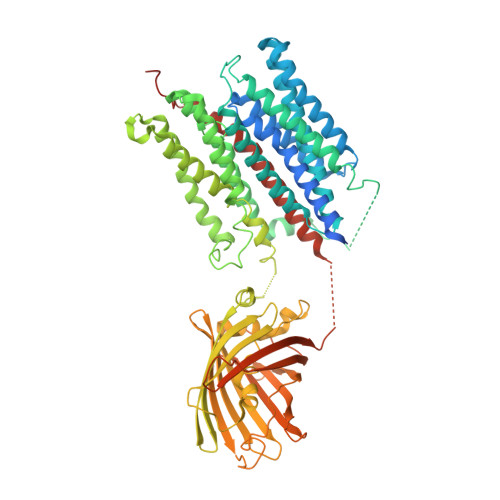Structural basis of the substrate recognition and inhibition mechanism of Plasmodium falciparum nucleoside transporter PfENT1.
Wang, C., Yu, L., Zhang, J., Zhou, Y., Sun, B., Xiao, Q., Zhang, M., Liu, H., Li, J., Li, J., Luo, Y., Xu, J., Lian, Z., Lin, J., Wang, X., Zhang, P., Guo, L., Ren, R., Deng, D.(2023) Nat Commun 14: 1727-1727
- PubMed: 36977719
- DOI: https://doi.org/10.1038/s41467-023-37411-1
- Primary Citation of Related Structures:
7WN0, 7WN1, 7YDQ - PubMed Abstract:
By lacking de novo purine biosynthesis enzymes, Plasmodium falciparum requires purine nucleoside uptake from host cells. The indispensable nucleoside transporter ENT1 of P. falciparum facilitates nucleoside uptake in the asexual blood stage. Specific inhibitors of PfENT1 prevent the proliferation of P. falciparum at submicromolar concentrations. However, the substrate recognition and inhibitory mechanism of PfENT1 are still elusive. Here, we report cryo-EM structures of PfENT1 in apo, inosine-bound, and inhibitor-bound states. Together with in vitro binding and uptake assays, we identify that inosine is the primary substrate of PfENT1 and that the inosine-binding site is located in the central cavity of PfENT1. The endofacial inhibitor GSK4 occupies the orthosteric site of PfENT1 and explores the allosteric site to block the conformational change of PfENT1. Furthermore, we propose a general "rocker switch" alternating access cycle for ENT transporters. Understanding the substrate recognition and inhibitory mechanisms of PfENT1 will greatly facilitate future efforts in the rational design of antimalarial drugs.
- Department of Obstetrics, Key Laboratory of Birth Defects and Related Disease of Women and Children of MOE, State Key Laboratory of Biotherapy, West China Second Hospital, Sichuan University, Chengdu, 610041, China.
Organizational Affiliation:

















